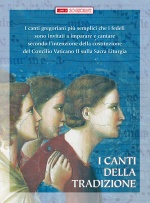
(Image by GregoBase)
Auxilia ad Missam in forma ordinaria celebrandam secundum Œcumenicum Concilium Vaticanum II

(Image by GregoBase)

(Image by GregoBase)
(Image by GregoBase)
Vi segnaliamo qui in particolare tre raccolte, con caratteristiche e scopi diversi fra loro.
La prima è il Graduale Romanum. Edito nel 1974 per volere di Papa Paolo VI, è il frutto del lavoro di un’apposita commissione vaticana che aveva il compito di applicare le indicazioni sulla musica liturgica formulate dal Concilio Vaticano II e, nel contempo, utilizzare il fondamentale lavoro sul canto gregoriano sviluppato dai monaci dell’abbazia di Solesmes.
Il secondo libro è il Graduale Simplex, pubblicato nel 1967 come conseguenza della raccomandazione contenuta nella costituzione conciliare Sacrosanctum Concilium: “Conviene che si prepari un’edizione che contenga melodie più semplici, ad uso delle chiese minori”.
Infine il Liber usualis, oggi reperibile nell’ultima versione aggiornata del 1962, che ha il vantaggio, rispetto alle prime due raccolte, di contenere non solo le melodie per la Messa ma anche quelle per l’Ufficio delle ore.
(Testo tratto dal documento I libri del canto gregoriano)
Por Alfredo Votta
O Graduale Simplex foi organizado para que as igrejas possam ter canto gregoriano mesmo que o Graduale Romanum seja difícil demais para seus cantores. Antes, a dificuldade impunha que o Próprio fosse cantado em tons salmódicos ou que a Missa não fosse cantada; agora existe o Graduale Simplex, com melodias mais simples e Próprios que se podem repetir dentro do mesmo tempo litúrgico.
A elaboração desse livro atende a um mandato do Concílio Vaticano II constante de Sacrosanctum Concilium, 117:117. Procure terminar-se a edição típica dos livros de canto gregoriano; prepare-se uma edição mais crítica dos livros já editados depois da reforma de S. Pio X.
Convirá preparar uma edição com melodias mais simples para uso das igrejas menores.Com efeito, na capa do livro lemos Graduale Simplex in usum minorum ecclesiarum – repetindo exatamente o texto do documento conciliar.
Numa situação mais próxima da ideal, as catedrais, por exemplo, usariam o Graduale Romanum, e mesmo as grandes paróquias. Entretanto, como o leitor sabe, a situação da Liturgia é diferente, e até mesmo em celebrações do papa na Basílica de São Pedro, em Roma, às vezes se utiliza… o Graduale Simplex!
Artigo completo aqui.
Canti per la santa Messa / Chants for the Holy Mass
© 2009 Catholic Bishops’ Conference of England and Wales
Download PDF here.
Alcuni ci dicono di non riuscire più a seguire con attenzione e devozione la messa, distratti da tanta incuria per quanto riguarda i canti e la musica durante il sacrificio eucaristico. E anch’io quando vado a dir messa in parrocchia da qualche mio amico parroco, rimango attonito.
Non bisogna farsi troppe illusioni di risalire in poco tempo dal baratro in cui siamo caduti. Bisogna ricominciare poco a poco. Fare dei piccoli passi. È un po’ come insegnare a parlare e a camminare a un bambino. O, meglio ancora, è come andare al catechismo, a imparare i fondamentali della nostra fede.Basterebbe che ogni parroco si procurasse il Liber cantualis dei padri benedettini di Solesmes che raccoglie i canti più semplici ed essenziali del gregoriano come il Credo, il Gloria, il Pater noster. O il libretto voluto da Paolo VI nel 1974 Iubilate Deo. C’è pure il repertorio pubblicato dal nostro Istituto: Celebriamo cantando i misteri della salvezza, un’antologia da noi preparata di canti gregoriani e in lingua italiana per tutte le circostanze dell’anno liturgico. Lo ristampiamo continuamente. Oltretutto, spesso inviamo i nostri insegnanti a dare una mano ai parroci.
Un’altra cosa facile da fare sarebbe far sì che nelle cattedrali, nelle chiese maggiori, nei seminari, nelle congregazioni religiose si celebrasse almeno una messa settimanale cantando il gregoriano nell’ordinario della messa. O, se risultasse troppo faticoso, almeno una volta al mese.
Leggi l’intervista completa sul sito di 30Giorni.

IL CD “I CANTI DELLA TRADIZIONE”
I canti gregoriani più semplici che i fedeli sono invitati a imparare e cantare secondo l’intenzione della costituzione del Concilio Vaticano II sulla Sacra Liturgia.
È possibile scaricare gratuitamente sia il CD che il libretto nell’area download del sito 30 Giorni.
THE CHANTS OF TRADITION
The most simple Gregorian chants that the faithful are invited to learn to sing according to the intention of Vatican Council II’s Constitution on the Sacred Liturgy.
CD and Pdf downloads
LES CHANTS DE LA TRADITION
Les chants grégoriens les plus simples que les fidèles sont invités à apprendre et à chanter conformément aux intentions de la Constitution du Concile Vatican II sur la sainte liturgie.
CD et Pdf Téléchargement
LOS CANTOS DE LA TRADICIÓN
Los cantos gregorianos más sencillos para que los fieles los aprendan y canten, según aconseja la Constitución del Concilio Vaticano II sobre la Sagrada Liturgia.
CD y Pdf área download
DIE GESÄNGE DER TRADITION
Die einfachsten Gregorianischen Gesänge, die die Gläubigen laut Weisung der Konzilskonstitution über die heilige Liturgie lernen und singen sollen.
CD und Pdf downloads
OS CANTOS DA TRADIÇÃO
Os cantos gregorianos mais simples que os fiéis são convidados a aprender e cantar segundo a intenção da Constituição do Concílio Vaticano II sobre a Sagrada Liturgia.
CD e Pdf área download